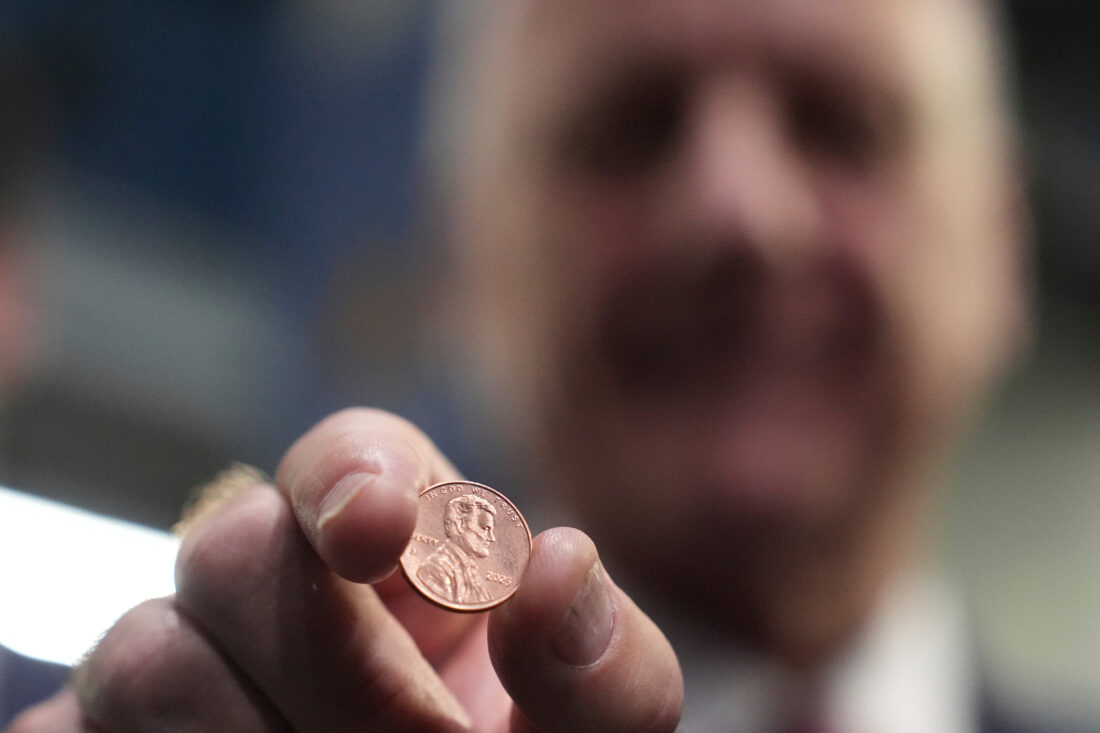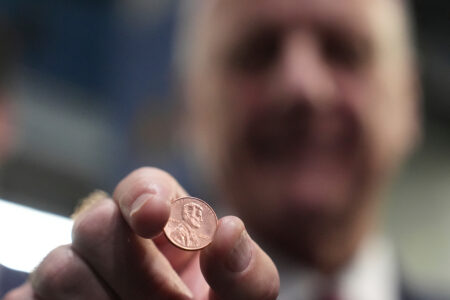Senator Proposes Fix For End Of The Penny

AP Photo Sen. James Skoufis, D-Cornwall, is pictured during a news conference in August.
- AP Photo Sen. James Skoufis, D-Cornwall, is pictured during a news conference in August.
- U.S. Treasurer Brandon Beach holds one of the last pennies pressed at the U.S. Mint in Philadelphia, Wednesday, Nov. 12, 2025. (AP Photo/Matt Slocum)
State Sen. James Skoufis, D-Cornwall, has introduced legislation (S.8580) that would require merchants to round cash purchases to the nearest five cent denomination in order to reduce the circulation of pennies within New York state. The “New Yorkers for Common Cents Act” will be open for legislative action when the next legislative session begins in January.
Retailers would be required to determine the total price of goods and services, including any discount, deduction, sales tax, or any other tax imposed. Then, if 1-2 or 6-7 cents are at the end of the price, the amount would be rounded down to the nearest amount divisible by 5. Amounts ending in 3-4 or 8-9 cents would be rounded up to the nearest amount divisible by 5. No change would be required for payments made by check, electronic fund transfer, money order, credit card, debit card or other electronic payment. State or municipal taxes imposed shall not apply to gains or losses from rounding.
“As pennies gradually disappear from circulation, cash transactions rounded to the cent will become increasingly impractical,” Skoufis wrote in his legislative justification. “Starting in the summer of 2025, businesses started posting signs in stores alerting customers of a “penny shortage” and asking them to use exact change when
possible.”

U.S. Treasurer Brandon Beach holds one of the last pennies pressed at the U.S. Mint in Philadelphia, Wednesday, Nov. 12, 2025. (AP Photo/Matt Slocum)
The last 1-cent coins were made Wednesday at the mint in Philadelphia. When it was introduced in 1793, a penny could buy a biscuit, a candle or a piece of candy. Now most of them are cast aside to sit in jars or junk drawers, and each one costs nearly 4 cents to make.
Some retailers voiced concerns in recent weeks as supplies ran low and the end of production drew near, the Associated Press reported. They said the phaseout was abrupt and came with no government guidance on how to handle transactions. Some businesses rounded prices down to avoid shortchanging shoppers. Others pleaded with customers to bring exact change. The more creative among them gave out prizes, such as a free drink, in exchange for a pile of pennies.
“As a result, each business is implementing its own policy on how to handle the change, which could lead to confusion and frustration amongst business owners and consumers alike,” Skoufis wrote in his legislative justification. “This bill would modernize and bring uniformity to how cash transactions are processed in New York state. This will help ensure a smooth transition as the nation moves away from the penny. The rounding system outlined in this bill is based on Canada’s federal policy when it abolished the country’s penny in 2013.”
Proponents of eliminating the coin cited cost savings, speedier checkouts at cash registers and the fact that some countries have already eliminated their 1-cent coins. Canada, for instance, stopped minting its penny in 2012.
Some banks began rationing supplies, a somewhat paradoxical result of the effort to address what many see as a glut of the coins. Over the last century, about half the coins made at mints in Philadelphia and Denver have been pennies.
But they cost far less to produce than the nickel, which costs nearly 14 cents to make. The diminutive dime, by comparison, costs less than 6 cents to produce, and the quarter nearly 15 cents.
The Associated Press contributed to this report.





